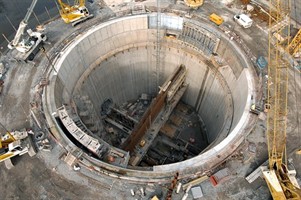Benzene exposure to workers during tunnelling

The Challenge
As part of upgrades to the Belfast wastewater and sewers
infrastructure, a main tunnel was under construction on the site of
a former gas works.
Soil samples had indicated the presence of various volatile
organic chemicals, of which benzene was the major component.
Initial monitoring (using both air and biological sampling) showed
that benzene exposure was being well controlled; however, benzene
levels began to rise rapidly and went well in excess of the UK
workplace exposure limit. This corresponded with a rise
in temperature (early May) - workers were complaining about the
heat and were sweating profusely inside their suits. A small number
exhibited signs of what was believed to be heat
stress/dehydration.
Benzene is a highly flammable liquid which also has some health
effects. It occurs naturally in crude oil, natural gas and some
ground waters and is also present in crude oil vapours. It can get
into the body by inhalation, absorption or ingestion.
The effects of benzene exposure can include: headaches,
tiredness, nausea, dizziness and unconsciousness if exposure is
very high (thousands of ppm). Long-term exposure to lower
concentrations of benzene can result in bone marrow suppression
leading to serious blood disorders such as anaemia, forms of
leukaemia and other cancers of the white blood cells.
Employers have requirements under The Control of Substances
Hazardous to Health Regulations 2002 (COSHH) to assess and control
worker exposure to benzene.
The Solution
HSE measured a specific metabolite of benzene called S-phenyl
mercapturic acid (SPMA) in urine samples from exposed workers. A
guidance value (equivalent to an 8-hour exposure at the workplace
exposure limit) allowed us to interpret the results.
In response to the high temperatures, workers had been provided
with additional bottled water. However, the subsequent series of
biological monitoring results showed significant benzene exposure
with 20% of samples exceeding the guidance value for urinary SPMA -
in the worst case by over 10-fold.
On investigation, it was found that, due to the heat and the
need to drink water more frequently, workers had been removing
their PPE in the tunnel during work, when leaving the tunnel at
break times, and at the end of their shifts. Some also reported
taking off their respirators to answer their mobile phones.
A decision was taken to stop working and during this time a
chiller was installed to improve working comfort. PPE was upgraded
and changes were made to working practice.
Work resumed with at least weekly biological monitoring. Prompt
analysis and reporting of the results allowed site management to
quickly intervene if biological monitoring indicated a loss of
exposure control. Following these improvements, a dramatic
reduction in SPMA levels was seen, with only three results out of
432 (0.7%) exceeding the guidance value.
The Outcome
This case study illustrates the value of biological monitoring
in situations where control of exposure primarily relies on RPE and
other PPE. Although air monitoring had identified 'hot spots' of
benzene contamination, the intermittent nature of these and the
extensive use of PPE meant that it was not sufficient to assess the
risk of exposure.
Biological monitoring was able to give an integrated measurement
of actual systemic exposure (despite the PPE) and highlight issues
with both the PPE and its use. Furthermore, since biological
samples are specific to an individual, it enabled any human factors
issues that might influence exposure control to be identified.
The improvements to control measures and working practice, made
in light of the elevated biological monitoring results, resulted in
significant reductions in worker exposure to benzene. Biological
monitoring enabled the job to be completed whilst giving continued
assurance that the workforce was not being exposed to potentially
hazardous levels of benzene.
With thanks to McCallum Safety & Health.
View more examples of our work in this
area.
Back to the top